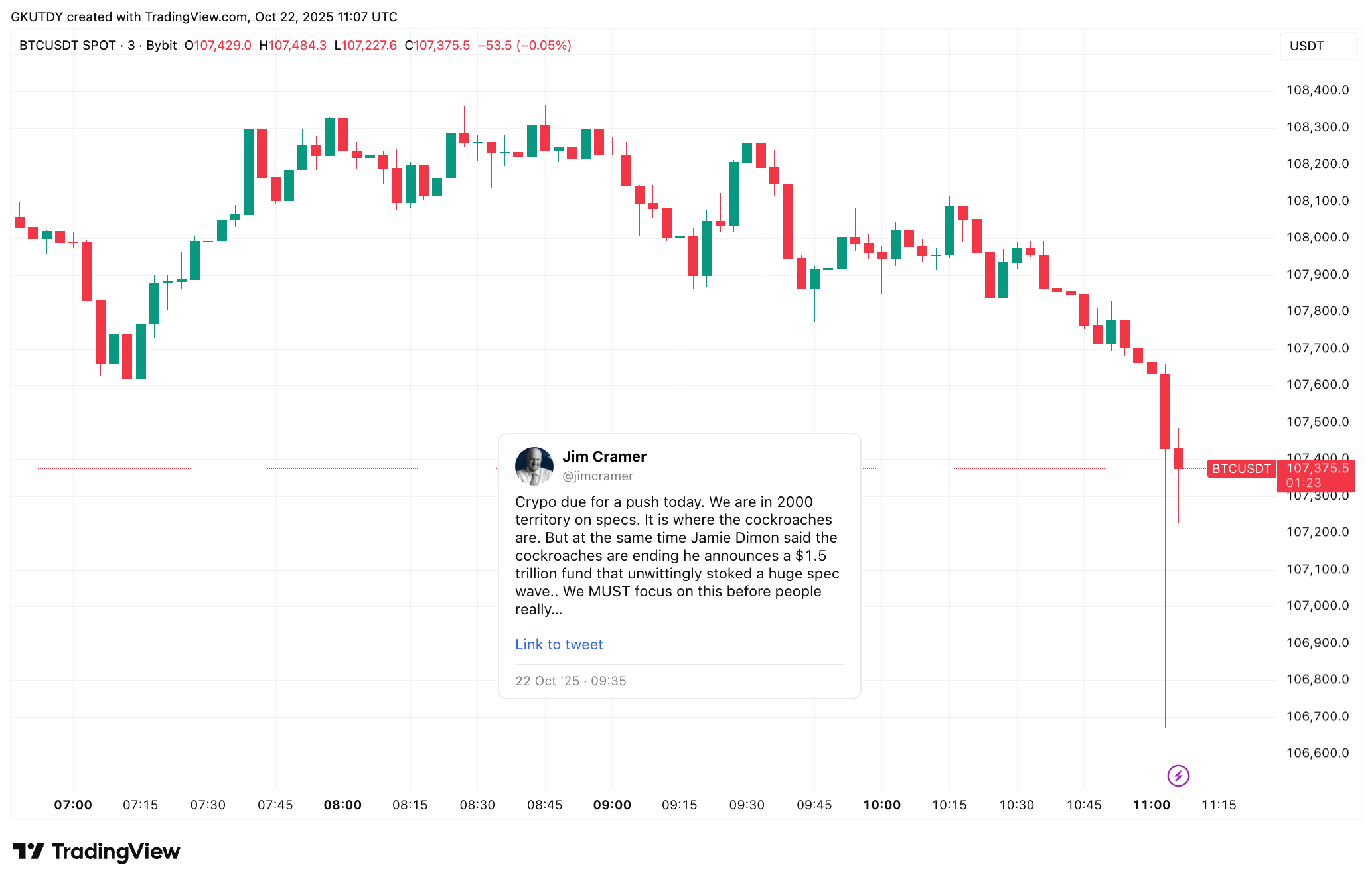Jim Cramer’s recent Bitcoin prediction of an upward push failed as the cryptocurrency dropped from $108,239 to $106,700, reinforcing the Inverse Cramer trading strategy where his calls often move in the opposite direction.
-
Jim Cramer, the CNBC host, posted on X predicting a Bitcoin surge while it traded at $108,239.
-
The price instead fell 1.4% to $106,700 within an hour, highlighting market rejection of his bullish outlook.
-
This event aligns with the Inverse Cramer phenomenon, where traders bet against his recommendations, backed by historical data showing frequent inaccuracies in his crypto forecasts.
Discover how Jim Cramer’s latest Bitcoin prediction backfired, dropping BTC prices and fueling the Inverse Cramer trade. Stay informed on crypto market trends and trading strategies for 2025.
What is the Inverse Cramer Effect in Bitcoin Trading?
The Inverse Cramer effect refers to a trading strategy where investors take positions opposite to the recommendations made by CNBC host Jim Cramer, particularly in volatile markets like Bitcoin. This phenomenon stems from Cramer’s track record of predictions that often fail to materialize, leading traders to view his calls as contrarian indicators. In the most recent instance, Cramer’s optimistic post about a Bitcoin push resulted in an immediate price decline, underscoring the strategy’s relevance in cryptocurrency trading.

BTC/USD by TradingView
How Did Jim Cramer’s Recent Bitcoin Prediction Unfold?
Jim Cramer, known for his appearances on CNBC’s Mad Money, shared a post on X stating that Bitcoin was “due for a push today” as the asset hovered around $108,239. This commentary came amid a broader market setup that Cramer likened to the speculative frenzy of the 2000 dot-com bubble, referring to areas of high leverage and weak investor positions as “where the cockroaches are.” His words were intended as a cautionary note paired with an expectation of upward momentum, drawing from observations of market dynamics reported by financial analysts at Bloomberg and Reuters.
However, the Bitcoin price action defied this outlook almost immediately. Within an hour of the post, BTC slipped to $106,700, marking a 1.4% decline. This movement was not a dramatic crash but sufficient to demonstrate underlying weakness in buying pressure. Trading data from platforms like TradingView showed consecutive red candlesticks, indicating seller dominance during that session. Market participants, familiar with Cramer’s history, quickly labeled this as another example of the Inverse Cramer trade gaining validation.
The Bitcoin chart at the time revealed a consolidation range established after October 10, with $107,800 serving as a critical support level. A breach below this could empower sellers further, while resistance lingered at $108,200, which bulls struggled to overcome. This price structure provided clear evidence of the day’s events: Cramer’s call for a surge met with rejection, adding fresh fuel to the contrarian strategy. According to on-chain metrics from Glassnode, trading volume spiked modestly during the dip, suggesting opportunistic buying at lower levels but no sustained rally.
Experts in cryptocurrency analysis, such as those cited in reports from CoinDesk, emphasize that such high-profile predictions can influence short-term sentiment but rarely dictate long-term trends. Cramer’s influence, while significant due to his media platform, is often weighed against broader indicators like macroeconomic data and institutional inflows. For instance, recent Federal Reserve statements on interest rates have played a more pivotal role in Bitcoin’s trajectory than individual commentator opinions.
Historically, the Inverse Cramer effect has roots in traditional finance but gained prominence in crypto circles around 2021 during the bull run. Traders on platforms like Reddit’s r/wallstreetbets have popularized memes and strategies betting against Cramer’s picks, with backtested data from quantitative firms like QuantConnect showing a notable edge in contrarian positions. In Bitcoin specifically, Cramer’s 2023 bearish stance preceded a significant rally, further cementing his reputation as a reverse indicator.
Frequently Asked Questions
What Makes Jim Cramer’s Bitcoin Predictions So Often Wrong?
Jim Cramer’s predictions, including those on Bitcoin, frequently miss the mark due to the unpredictable nature of cryptocurrency markets influenced by global events, regulatory news, and whale activity. Data from past CNBC segments analyzed by financial watchdogs like FactSet reveals an accuracy rate below 50% for high-volatility assets, leading traders to adopt the Inverse Cramer approach for hedging.
Is the Inverse Cramer Strategy Reliable for Bitcoin in 2025?
The Inverse Cramer strategy can serve as a sentiment gauge for Bitcoin trading in 2025, especially during periods of media hype, but it should complement technical analysis and fundamentals. As voice search queries increasingly focus on real-time crypto advice, remember that no single indicator guarantees success—diversify based on confirmed trends from reliable data sources.
Key Takeaways
- Jim Cramer’s Influence on Markets: His X posts, like the recent Bitcoin push prediction, often spark immediate reactions, but outcomes typically invert, as seen in the 1.4% drop to $106,700.
- Bitcoin’s Current Range: Trading between $107,800 support and $108,200 resistance highlights consolidation, with weak bids underscoring vulnerability to contrarian signals.
- Trading Lesson: Use the Inverse Cramer effect as one tool among many—monitor on-chain data and macroeconomic cues for informed decisions in volatile crypto environments.
Conclusion
In summary, Jim Cramer’s Bitcoin prediction of an imminent push not only failed but exemplified the enduring Inverse Cramer effect, as prices declined sharply from $108,239 to $106,700. This incident, set against a speculative market reminiscent of past bubbles, reinforces the value of skepticism toward high-profile calls in cryptocurrency trading. As Bitcoin navigates its post-October range, investors should prioritize data-driven strategies over singular opinions. Looking ahead, with potential regulatory clarity and institutional adoption on the horizon, staying vigilant could position traders for sustained gains in 2025—consider reviewing your portfolio’s exposure to such sentiment-driven volatility today.
